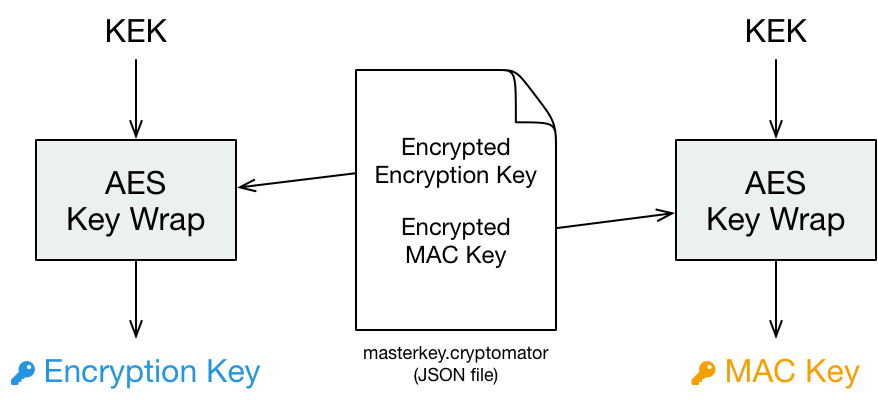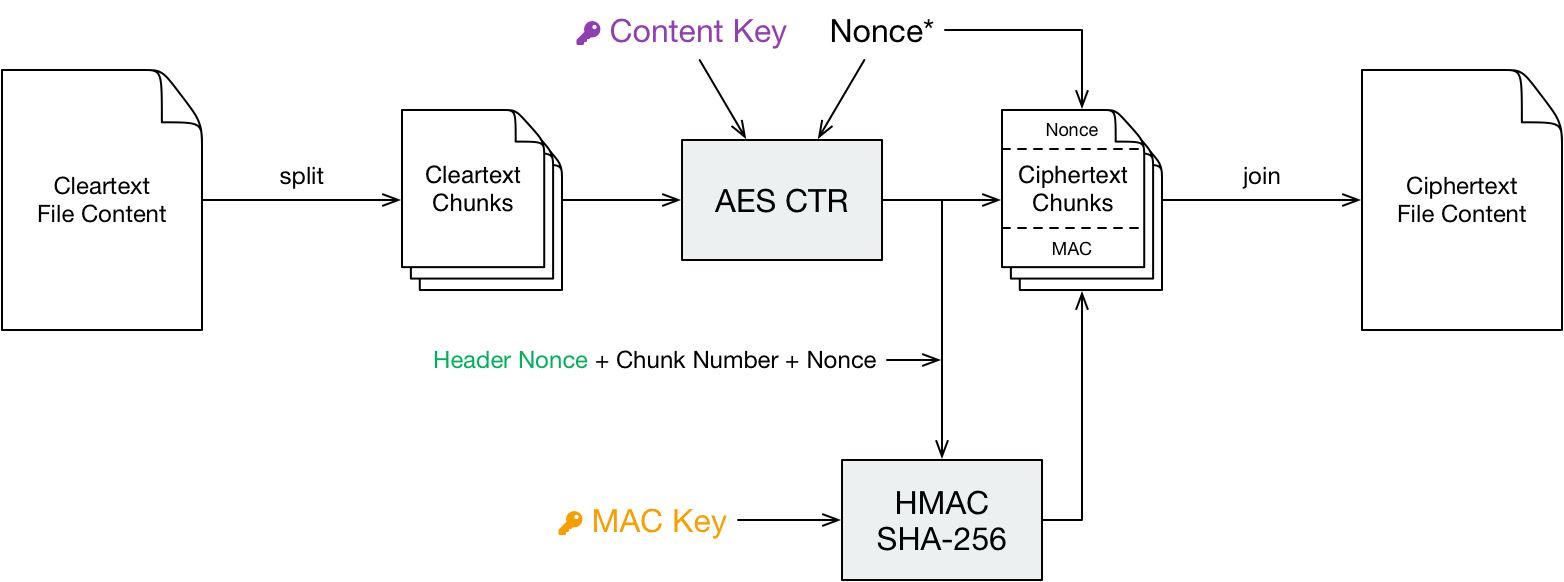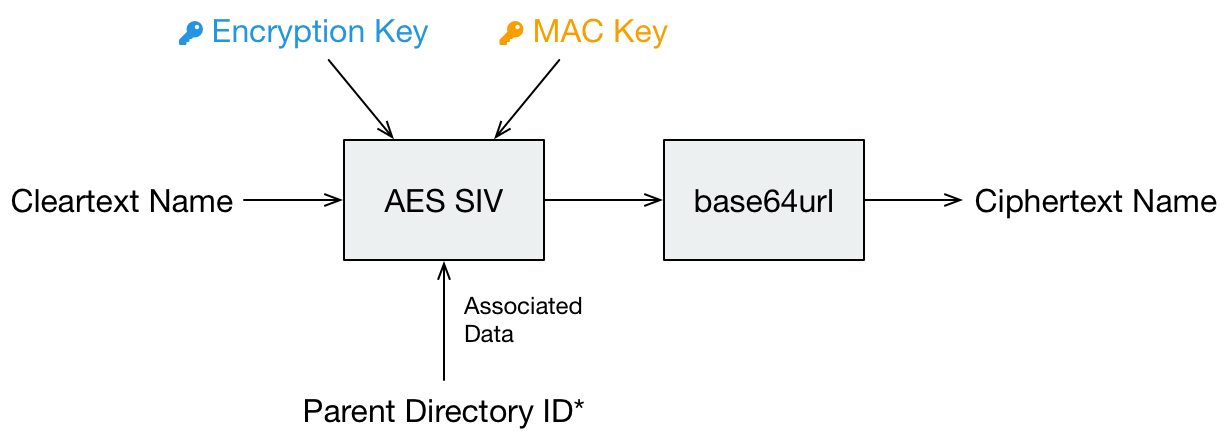Security Architecture
Virtual Filesystem
Cryptomator provides a virtual drive. Add, edit, remove files as you’re used to with just any disk drive.
Files are transparently en- and decrypted. There are no unencrypted copies on your hard disk drive. With every access on your files inside the virtual drive, Cryptomator will en- and decrypt these files on-the-fly.
Currently Dokany or WinFsp (on Windows) and FUSE (on macOS and Linux) are our frontends of choice. If they’re not available on your system, Cryptomator will fall back on WebDAV, as it is supported on every major operating system. WebDAV is an HTTP-based protocol and Cryptomator acts as a WebDAV server accepting so-called loopback connections on your local machine only.
Whenever your file manager accesses files through this virtual drive, Cryptomator will process this request via the following layers.
Vault Configuration
Every vault must have a vault configuration file named vault.cryptomator in the root directory of the vault.
It is a JWT containing basic information about the vault and specification what key to use.
The JWT is signed using the 512 bit raw masterkey.
This is an example of an encoded vault configuration file:
eyJraWQiOiJtYXN0ZXJrZXlmaWxlOm1hc3RlcmtleS5jcnlwdG9tYXRvciIsInR5cCI6IkpXVCIsImFsZyI6IkhTMjU2In0.eyJmb3JtYXQiOjgsInNob3J0ZW5pbmdUaHJlc2hvbGQiOjIyMCwianRpIjoiY2U5NzZmN2EtN2I5Mi00Y2MwLWI0YzEtYzc0YTZhYTE3Y2Y1IiwiY2lwaGVyQ29tYm8iOiJTSVZfQ1RSTUFDIn0.IJlu4dHb3fqB2fAk9lf8G8zyEXc7OLB-5m9aNxOEXIQ
The decoded header:
{
"kid": "masterkeyfile:masterkey.cryptomator", /* URI of where to get the key */
"typ": "JWT",
"alg": "HS256" /* current implementations also support HS384 and HS512 */
}
The decoded payload:
{
"format": 8, /* vault format for checking software compatibility */
"shorteningThreshold": 220, /* how many characters in ciphertext filenames before shortening */
"jti": "ce976f7a-7b92-4cc0-b4c1-c74a6aa17cf5", /* random UUID to uniquely identify the vault */
"cipherCombo": "SIV_CTRMAC" /* currently only SIV_CTRMAC is supported */
}
When opening a vault, the following steps have to be followed:
Decode
vault.cryptomatorwithout verification.Read
kidheader and, depending on its value, retrieve the masterkey from the specified location.Verify the JWT signature using the masterkey.
Make sure
formatandcipherComboare supported.
Masterkey Derivation
Each vault has its own 256 bit encryption as well as MAC masterkey used for encryption of file specific keys and file authentication, respectively.
These keys are random sequences generated by a CSPRNG.
We use SecureRandom with SHA1PRNG, seeded with 440 bits from SecureRandom.getInstanceStrong().
Both keys are encrypted using RFC 3394 key wrapping with a KEK derived from the user’s password using scrypt.
encryptionMasterKey := createRandomBytes(32)
macMasterKey := createRandomBytes(32)
kek := scrypt(password, scryptSalt, scryptCostParam, scryptBlockSize)
wrappedEncryptionMasterKey := aesKeyWrap(encryptionMasterKey, kek)
wrappedMacMasterKey := aesKeyWrap(macMasterKey, kek)

The wrapped keys and the parameters needed to derive the KEK are then stored as integers or Base64-encoded strings in a JSON file named masterkey.cryptomator, which is located in the root directory of the vault.
{
"version": 999, /* deprecated, vault format is now specified in the vault configuration */
"scryptSalt": "QGk...jY=",
"scryptCostParam": 16384,
"scryptBlockSize": 8,
"primaryMasterKey": "QDi...Q==", /* wrappedEncryptionMasterKey */
"hmacMasterKey": "L83...Q==", /* wrappedMacMasterKey */
"versionMac": "3/U...9Q=" /* HMAC-256 of vault version to prevent undetected downgrade attacks */
}
When unlocking a vault the KEK is used to unwrap (i.e. decrypt) the stored masterkeys.

File Header Encryption
The file header stores certain metadata, which is needed for file content encryption. It consists of 88 bytes.
16 bytes nonce used during header payload encryption.
40 bytes AES-CTR encrypted payload consisting of:
8 bytes filled with 1 for future use (formerly used for file size) and
32 bytes file content key.
32 bytes header MAC of the previous 56 bytes.
headerNonce := createRandomBytes(16)
contentKey := createRandomBytes(32)
cleartextPayload := 0xFFFFFFFFFFFFFFFF . contentKey
ciphertextPayload := aesCtr(cleartextPayload, encryptionMasterKey, headerNonce)
mac := hmacSha256(headerNonce . ciphertextPayload, macMasterKey)

*Random per file change
File Content Encryption
This is where your actual file contents get encrypted.
The cleartext is broken down into multiple chunks, each up to 32 KiB + 48 bytes consisting of:
16 bytes nonce,
up to 32 KiB encrypted payload using AES-CTR with the file content key, and
32 bytes MAC consisting of:
file header nonce (to bind this chunk to the file header),
chunk number as 8 byte big endian integer (to prevent undetected reordering),
nonce, and
encrypted payload.
Afterwards, the encrypted chunks are joined preserving the order of the cleartext chunks. The payload of the last chunk may be smaller than 32 KiB.
cleartextChunks[] := split(cleartext, 32KiB)
for (int i = 0; i < length(cleartextChunks); i++) {
chunkNonce := createRandomBytes(16)
ciphertextPayload := aesCtr(cleartextChunks[i], contentKey, chunkNonce)
mac := hmacSha256(headerNonce . bigEndian(i) . chunkNonce . ciphertextPayload, macMasterKey)
ciphertextChunks[i] := chunkNonce . ciphertextPayload . mac
}
ciphertextFileContent := join(ciphertextChunks[])

*Random per chunk change
Directory IDs
Each directory has a unique ID that is required during filename encryption. For historical reasons, the directory ID is a string, even though any byte sequence would do the job.
The directory ID for the root directory is the empty string. For all other directories, it is a random sequence of at most 36 ASCII chars. We recommend using random UUID.
dirId := createUuid()
When traversing directories, the directory ID of a given subdirectory is processed in four steps to determine the storage path inside the vault:
Encrypting the directory ID using AES-SIV in order to encrypt directory hierarchies.
Creating a SHA1 hash of the encrypted directory ID in order to get a uniform length.
Encoding the hash with Base32 to get a string of printable chars.
Constructing the directory path out of the Base32-encoded hash.
dirIdHash := base32(sha1(aesSiv(dirId, null, encryptionMasterKey, macMasterKey)))
dirPath := vaultRoot + '/d/' + substr(dirIdHash, 0, 2) + '/' + substr(dirIdHash, 2, 30)
Regardless of the hierarchy of cleartext paths, ciphertext directories are always stored in a flattened structure. All directories will therefore effectively be siblings (or cousins, to be precise).
Filename Encryption
The cleartext name of a file gets encoded using UTF-8 in Normalization Form C to get a unique binary representation.
Cryptomator uses AES-SIV to encrypt names. The directory ID of the parent folder is passed as associated data. This prevents undetected movement of files between directories.

*Unencrypted directory ID of the partent dir as described above
ciphertextName := base64url(aesSiv(cleartextName, parentDirId, encryptionMasterKey, macMasterKey)) + '.c9r'
Depending on the kind of node, the encrypted name is then either used to create a file or a directory.
Files are stored as files.
Non-files are stored as directories. The type of the node then depends on the directory content.
Directories are denoted by a file called
dir.c9rcontaining aforementioned directory ID.Symlinks are denoted by a file called
symlink.c9rcontaining the encrypted link target.Further types may be appended in future releases.
Thus, a cleartext directory structure like this:
.
├─ File.txt
├─ SymlinkToFile.txt
├─ Subdirectory
│ └─ ...
└─ ...
Becomes a ciphertext directory structure like this:
.
├─ d
│ ├─ BZ
│ │ └─ R4VZSS5PEF7TU3PMFIMON5GJRNBDWA
│ │ ├─ 5TyvCyF255sRtfrIv**83ucADQ==.c9r # File.txt
│ │ ├─ FHTa55bH*sUfVDbEb0gTL9hZ8nho.c9r # Subdirectory
│ │ │ └─ dir.c9r # contains dirId
│ │ └─ gLeOGMCN358*UBf2Qk9cWCQl.c9r # SymlinkToFile.txt
│ │ └─ symlink.c9r # contains link target
│ └─ FC
│ └─ ZKZRLZUODUUYTYA4457CSBPZXB5A77 # contains contents of Subdirectory
│ └─ ...
├─ masterkey.cryptomator
├─ masterkey.cryptomator.DFD9B248.bkup
└─ vault.cryptomator
Name Shortening
Note
This layer doesn’t provide any additional security. Its sole purpose is to maximize compatibility.
To maximize compatibility, we need to make sure the ciphertext names don’t exceed a length of 255 chars. As some cloud sync services might want to add a suffix to a file in case of conflicts, we decided to use at most 220 chars.
If an encrypted name (including its .c9r extension) exceeds these 220 chars, we will instead create a directory named after its much shorter SHA-1 hash and the .c9s extension.
Additionally we will create a reverse-mapping file named name.c9s containing the original file inside of this directory.
if (length(ciphertextName) > 220) {
deflatedName := base64url(sha1(ciphertextName)) + '.c9s'
inflatedNameFilePath := deflatedName + '/name.c9s'
fileContentsPath := deflatedName + '/contents.c9r'
symlinkFilePath := deflatedName + '/symlink.c9r'
dirIdFilePath := deflatedName + '/dir.c9r'
}
Again, we have to distinguish the kind of a node.
Non-files (such as symlinks or directories) are stored as a directory anyway. Nothing changes for them.
Files, on the other hand, need a different place to store their contents. Therefore, we introduce the
contents.c9rfile inside the.c9sdirectory.
A vault containing several nodes with very long names might result in a ciphertext structure like this:
.
├─ d
│ ├─ BZ
│ │ └─ R4VZSS5PEF7TU3PMFIMON5GJRNBDWA
│ │ ├─ 5TyvCyF255sRtfrIv**83ucADQ==.c9r
│ │ ├─ FHTa55bH*sUfVDbEb0gTL9hZ8nho.c9r
│ │ │ └─ dir.c9r
│ │ ├─ gLeOGMCN358*UBf2Qk9cWCQl.c9r
│ │ │ └─ symlink.c9r
│ │ ├─ IjTsXtReTy6bAAuxzLPV9T0k2vg=.c9s # shortened name...
│ │ │ ├─ contents.c9r # ...node is a regular file
│ │ │ └─ name.c9s # ...mapping to this full name
│ │ ├─ q2nx5XeNCenHyQvkFD4mxYNrWpQ=.c9s # shortened name...
│ │ │ ├─ dir.c9r # ...node is a directory
│ │ │ └─ name.c9s # ...mapping to this full name
│ │ └─ u*JJCJE-T4IH-EBYASUp1u3p7mA=.c9s # shortened name...
│ │ ├─ name.c9s # ...mapping to this full name
│ │ └─ symlink.c9r # ...node is a symlink
│ └─ FC
│ └─ ZKZRLZUODUUYTYA4457CSBPZXB5A77
│ └─ ...
├─ masterkey.cryptomator
├─ masterkey.cryptomator.DFD9B248.bkup
└─ vault.cryptomator
Backup Directory IDs
Note
This layer is optional and not required for a complete implementation of the Cryptomator Encryption Scheme. It doesn’t provide any additional security. Its sole purpose is to increase data recoverability in case of missing or damaged directory files.
By obfuscating the hierarchy of cleartext paths using dir.c9r files, which contain directory IDs, the directory structure is more vulnerable to problems like incomplete synchronization or bit rotting.
When a directory file is missing or damaged, the dirPath cannot be computed, which effectively makes the directory content inaccessible in the virtual filesystem.
In theory, the contents of the encrypted content of these files can be recovered.
But since the filename encryption is dependent on the directory ID of the parent folder, which is only stored in the directory file, names of all items (files, directories, or symlinks) are lost.
To alleviate this issue, a backup directory file will be stored during the creation of a directory.
Inside the ciphertext directory, a file named dirid.c9r will be created, which contains the directory ID of its parent folder.
It is encrypted like a regular ciphertext file.